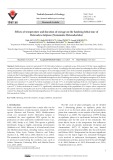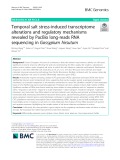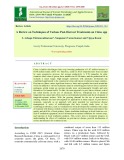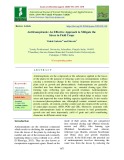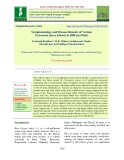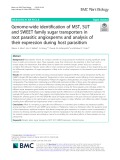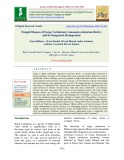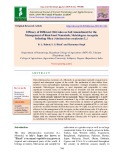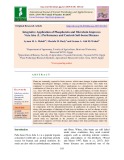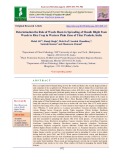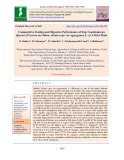
Causes significant crop losses
-
Citrus production is declining worldwide due to several biotic and abiotic factors. The diseases caused by Phytophthora spp. present major economic risks since they are soil-borne and spread quickly if environmental conditions are favorable, or irrigation is poorly managed. Phytophthora species are present in all citrus-producing areas around the world causing significant losses in crop yield and affecting tree health.
 13p
13p  lyhuyenthu
lyhuyenthu
 31-01-2023
31-01-2023
 7
7
 2
2
 Download
Download
-
Hypoxia induced by flooding causes significant losses to crop production almost every year. However, the molecular network of submergence signaling pathway is still poorly understood. According to previous studies, transgenic plants overexpressing the WRKY33 gene showed enhanced resistance to submergence stress.
 10p
10p  vihagrid
vihagrid
 30-01-2023
30-01-2023
 5
5
 3
3
 Download
Download
-
Mediterranean cereal cyst nematode (CCN) Heterodera latipons is considered as one of the main CCN that causes significant economic losses in the production of intolerant cereal crops in Turkey. Accordingly, this study aimed at evaluating the effect of different storing temperatures and durations on the emergence of second-stage juveniles (J2s) of the nematode populations obtained from the eastern Mediterranean (Adana and Hatay) and south-eastern (Gaziantep and Kilis) regions of Turkey. The obtained results revealed a variation in the J2s hatching profiles of the regional nematode populations.
 10p
10p  dolomite36
dolomite36
 30-12-2021
30-12-2021
 16
16
 0
0
 Download
Download
-
Cotton (Gossypium hirsutum) is considered a fairly salt tolerant crop however, salinity can still cause significant economic losses by affecting the yield and deteriorating the fiber quality. We studied a salt-tolerant upland cotton cultivar under temporal salt stress to unfold the salt tolerance molecular mechanisms.
 15p
15p  vijeeni2711
vijeeni2711
 30-06-2021
30-06-2021
 10
10
 1
1
 Download
Download
-
Citrus is India's third-largest fruit crop, boosting production of 1.07 million hectares to 10.48 million tonnes (2013-14). Therefore, yields of 20-25 tonnes/ha have been recorded by some progressive growers, but average productivity is 9.78 tonnes/ha. In other countries where citrus is grown, these numbers are 40-50 tonnes, and the production life in orchards is much longer. High-strength cultivation with automatic fertilization has contributed significantly to the commercial citrus cultivation revolution in many countries.
 11p
11p  caygaocaolon11
caygaocaolon11
 21-04-2021
21-04-2021
 8
8
 1
1
 Download
Download
-
Antitranspirants are the compounds or the substances applied to the leaves of the plants for the purpose of reducing water loss (transpiration) without causing a momentous change in the various important processes of the plant such as growth and photosynthesis. Antitranspirants are generally classified into four distinct categories viz., stomatal closing type, filmforming type, reflecting type and growth retardant.
 8p
8p  kethamoi7
kethamoi7
 26-08-2020
26-08-2020
 7
7
 1
1
 Download
Download
-
Rice (Oryza sativa L.) is an important cereal crop and prone to many diseases out ofwhich, rice blast caused by Pyricularia grisea is of significant economic importance due to its destructive nature leading to serious yield loss. Blast infected leaves of rice, Panicum grass and finger millet were collected from different fields of OUAT farm, Bhubaneswar.
 6p
6p  angicungduoc6
angicungduoc6
 22-07-2020
22-07-2020
 17
17
 2
2
 Download
Download
-
Cowpea (Vigna unguiculata (L.)Walp.) is a poor men’s protein source. It is one of the most ancient human food sources and an important grain legume and hay crop in many tropical and subtropical regions. It is grown in Tamil Nadu and Andhra Pradesh widely as rainfed crop. Cowpea is affected by many diseases caused by viruses, bacteria and fungi. Among the fungal diseases, the charcoal rot caused by Macrophomina phaseolina (Tassi.) Goid causes significant loss in yield. M. phaseolinais a soil borne plant pathogen with a very wide host range.
 12p
12p  chauchaungayxua6
chauchaungayxua6
 26-06-2020
26-06-2020
 10
10
 0
0
 Download
Download
-
Begomoviruses being the largest genera of Geminiviridae cause significant economical losses in a wide variety of crops in several tropical and subtropical regions of India and a major threats to food security. Begomoviruses are transmitted by the whitefly (Bemisia tabaci) in a circulative persistent manner. Begomoviruses as of their small genomes (ssDNA) and limited coding capacities, rely heavily on host machineries for infection. They interact with a wide range of plant proteins and process them to support viral DNA replication, gene expression, movement, and to neutralize host defenses.
 12p
12p  trinhthamhodang1213
trinhthamhodang1213
 29-05-2020
29-05-2020
 15
15
 0
0
 Download
Download
-
Root parasitic weeds are a major constraint to crop production worldwide causing significant yearly losses in yield and economic value. These parasites cause their destruction by attaching to their hosts with a unique organ, the haustorium, that allows them to obtain the nutrients (sugars, amino acids, etc.) needed to complete their lifecycle.
 18p
18p  vishikamaru2711
vishikamaru2711
 25-04-2020
25-04-2020
 16
16
 0
0
 Download
Download
-
Cabbage [Brassica oleracea var capitata (L.)] is an economically important cool season vegetable crop belongs to family Cruciferae. Alternaria leaf spot of cabbage caused by Alternaria brassicicola is the most destructive disease causing significant yield losses every year
 5p
5p  kethamoi4
kethamoi4
 18-04-2020
18-04-2020
 17
17
 1
1
 Download
Download
-
Banana and plantains is the most important tropical fruit crop in the world, which serves as a major food and source of income in many countries. Bananas are severely infected by several pathogens one such Fusarium oxysoporum f. sp. Cubense which causes significant crop losses in the fields. In this study fusarium wilt screening was carried out on chemically induced mutants and molecular analysis was done to assess the acquired resistance to Fusarium oxysoporum f. sp. cubense.
 9p
9p  trinhthamhodang1212
trinhthamhodang1212
 06-04-2020
06-04-2020
 10
10
 1
1
 Download
Download
-
Large or Black cardamom (Amomum subulatum Roxb.) is commercially cultivated in Nepal and India. As many as 25 diseases have been reported till date. Based on severity, spread and extent of damage, these are grouped as major and minor disease occurring in main plantation and in nursery. The plant is prone to several diseases among which fungal and viral diseases cause significant loss to yield. The fungal diseases are prevalent from the nursery to plantation field.
 6p
6p  quenchua4
quenchua4
 06-04-2020
06-04-2020
 10
10
 1
1
 Download
Download
-
Okra [Abelmoschus esculentus (L.) Moench.] is an important vegetable crop grown in tropical and subtropical regions of the world. The production of okra suffers from number of pest and pathogens including nematodes. Amongst nematodes, root-knot nematode, Meloidogyne incognita is most important and responsible to cause significant economic losses in worldwide due to favorable soil and environmental conditions.
 10p
10p  nguaconbaynhay4
nguaconbaynhay4
 22-03-2020
22-03-2020
 16
16
 1
1
 Download
Download
-
Plants are constantly exposed to biotic stresses, which cause changes in plant metabolism including physiological damages, leading to crop productivity losses. This study was conducted to investigate bio-fertilizer applications (i.e., phosphorein, microbein, and combination of them at a ratio of 1:1 for seed before sowing) influences on two varieties (i.e., Giza 429 and Giza 40) of Vicia faba (L.) plant performances on borne diseasesinfected soil. Growth, yield and its quality, physio-biochemical attributes, nutrient contents and disease assessment were investigated.
 19p
19p  caygaocaolon2
caygaocaolon2
 11-03-2020
11-03-2020
 16
16
 0
0
 Download
Download
-
Rice is a staple food for human being all over the world and India is the second largest producer and consumer of rice at global level. Production of rice in India is limited by several biotic and abiotic factors. Rice sheath blight (Rhizoctonia solani AG1-IA) is one of the most important factor causes significant grain yield and quality losses at worldwide. Yield losses of up to 50% have been reported under most conducive environments in India. Several uncultivated (weeds) and cultivated plant species are known to act as alternate and collateral hosts of R.
 11p
11p  caygaocaolon3
caygaocaolon3
 09-03-2020
09-03-2020
 10
10
 1
1
 Download
Download
-
The tomato (var. sumberson) is highly susceptible to diseases caused by microorganisms as well as pest infestations; as a result serious loss is caused thereof in the production of those crops. On the background of these facts, the research was focused on controlling the diseases through the selected treatments with the objectives of evaluating the efficacy of Lantana camara extract, Balanites extract and their combinations to assess on controlling the pest/disease incidence and severity in tomato field conducted in Hamelmalo Agricultural College.
 16p
16p  nguathienthan3
nguathienthan3
 27-02-2020
27-02-2020
 17
17
 0
0
 Download
Download
-
Shallot, Allium cepa var aggregatum L. (Alliaceae) is one of the major bulbous vegetable grown both as garden and field crop in India. The major leaf feeding insect pests of onion, Spodoptera exigua, Spodoptera litura, Helicoverpa armigera and the recently invasive insect Spodoptera frugiperda were causing destructive damage to the plant and made economic yield loss. Food consumption indices were studied under laboratory condition at room temperature 28 ± 20C and it is one of the parameter to identify the damage potential of insects.
 11p
11p  chauchaungayxua3
chauchaungayxua3
 07-02-2020
07-02-2020
 13
13
 1
1
 Download
Download
-
Cotton is an important crop used globally for its natural fibre and seed. Fusarium wilt, caused by the fungus Fusarium oxysporum f. sp. vasinfectum, is a major disease of cotton capable of causing significant economic loss. The fungus persists in soil as chlamydospores and in association with the roots of susceptible, resistant and non-cotton hosts as well as in seed. In the present investigation, the major cotton growing areas of Tamil Nadu were surveyed for assessing the per cent wilt incidence, the maximum disease incidence of 28.
 7p
7p  nguathienthan2
nguathienthan2
 19-12-2019
19-12-2019
 11
11
 1
1
 Download
Download
-
Bakanae of rice cause by Fusarium moniliforme [sexual stage: Gibberella fujikuroi] is one of the important disease of rice occurring throughout rice (Oryza sativa L.) growing regions of the world. Bakanae disease also known as “Foolish seedling disease” is emerged as a significantly important disease in rice growing country in Asia. The word Bakanae is derived from the Japanese word which means “Foolish”. The incidence of this disease was reported high from the part of Punjab, Haryana and Uttarakhand and responsible for 15 % losses throughout the India.
 8p
8p  quenchua2
quenchua2
 16-12-2019
16-12-2019
 14
14
 0
0
 Download
Download
CHỦ ĐỀ BẠN MUỐN TÌM











